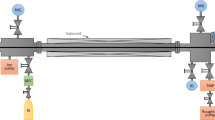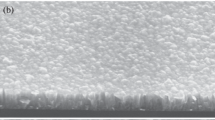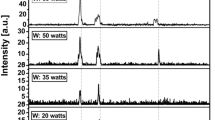Abstract
Non-evaporable getter (NEG) films are an integral part of many particle accelerators. These films provide conductance-free evenly distributed pumping, a low thermal outgassing rate, and a low photon-and electron-stimulated desorption. These characteristics make it an ideal solution for resolving the non-uniform pressure distribution in conductance-limited narrow vacuum tubes. In this study, ternary Ti–Zr–V films were deposited on Si substrates and Ag–Cu (Ag 0.085 wt%) tubes with an inner diameter of 22 mm. All Ti–Zr–V films were prepared from an alloy target using the same DC magnetron sputtering parameters. The compositions and corresponding chemical bonding states were analyzed by X-ray photoelectron spectroscopy after activation at different temperatures. The test particle Monte Carlo (TPMC) method was used to measure the sticking probability of the Ti–Zr–V film based on pressure readings during gas injection. The results indicate that activation commences at temperatures as low as 150 °C and Ti0, Zr0, and V0 exist on the surface after annealing at 180 °C for 1 h. Ti–Zr–V films can be fully activated at 180 °C for 24 h. The CO sticking probability reaches 0.15, with a pumping capacity of 1 monolayer.







Similar content being viewed by others
References
Z.B. Sun, L. Shang, F.L. Shang et al., Simulation study of longitudinal injection scheme for HALS with a higher harmonic cavity system. Nucl. Sci. Tech. 30, 113 (2019). https://doi.org/10.1007/s41365-019-0627-x
D.C. Zhu, J.H. Yue, Y.F. Sui et al., Performance of beam size monitor based on Kirkpatrick–Baez mirror at SSRF. Nucl. Sci. Tech. 29, 148 (2018). https://doi.org/10.1007/s41365-018-0477-y
P. He, Accelerator vacuum technology challenges for next generation synchrotron-light sources. In Proceedings of the 8th International Particle Accelerator Conference, IPAC2017, Copenhagen, Denmark, pp. 4830–4835 (2017). https://doi.org/10.18429/JACoW-IPAC2017-FRXAB1
V.V. Anashin, I.R. Collins, R.V. Dostovalov et al., Comparative study of photodesorption from TiZrV coated and uncoated stainless steel vacuum chambers. Vacuum 75, 155–159 (2004). https://doi.org/10.1016/j.vacuum.2004.01.080
O.B. Malyshev, A.P. Smith, R. Valizadeh et al., Electron stimulated desorption from bare and nonevaporable getter coated stainless steels. J. Vac. Sci. Technol. A 28, 1215–1225 (2010). https://doi.org/10.1116/1.3478672
C. Benvenuti, P. Chiggiato, P.C. Pinto et al., Vacuum properties of TiZrV non-evaporable getter films. Vacuum 60, 57–65 (2001). https://doi.org/10.1016/S0042-207X(00)00246-3
C. Benvenuti, Non-evaporable getters: from pumping strips to thin film coatings. In: 6th European Particle Accelerator Conference, EPAC1998, Stockholm, Sweden, pp. 200–204 (1998) https://accelconf.web.cern.ch/e98/PAPERS/THZ02A.PDF
C. Benvenuti, P. Chiggiato, A. Mongelluzzo et al., Influence of the elemental composition and crystal structure on the vacuum properties of Ti–Zr–V nonevaporable getter films. J. Vac. Sci. Technol. A 19, 2925–2930 (2001). https://doi.org/10.1116/1.1414122
E. Al-Dmour, M.J. Grabski, The vacuum system of MAX IV storage rings: Installation and conditioning. In: Proceedings of the 8th International Particle Accelerator Conference, IPAC2017, Copenhagen, Denmark, pp. 3468–3470 (2017). https://doi.org/10.18429/JACoW-IPAC2017-WEPVA09
J.M. Jimenez, LHC: the world’s largest vacuum systems being operated at CERN. Vacuum 84, 2–7 (2009). https://doi.org/10.1016/j.vacuum.2009.05.015
C. Herbeaux, N. Bèchu, A. Conte, et al., Vacuum conditioning of the SOLEIL storage ring with extensive use of NEG coating. In: 11th European Particle Accelerator Conference, EPAC2008, Genoa, Italy, pp. 3696–3698 (2008) https://accelconf.web.cern.ch/e08/papers/thpp142.pdf
O.B. Malyshev, M.P. Cox, Design modelling and measured performance of the vacuum system of the diamond light source storage ring. Vacuum 86, 1692–1696 (2012). https://doi.org/10.1016/j.vacuum.2012.03.015
M. Hahn, Operational experience and relation to deposition process for NEG-coated chambers installed on the ESRF electron storage ring. Vacuum 81, 759–761 (2007). https://doi.org/10.1016/j.vacuum.2005.11.051
O.B. Malyshev, Vacuum in Particle Accelerators: Modelling, Design and Operation of Beam Vacuum Systems (Wiley, Hoboken, 2020).
Z. Abboud, O. Moutanabbir, Temperature-dependent in situ studies of volatile molecule trapping in low-temperature-activated Zr alloy-based getters. J. Phys. Chem. C 121, 3381–3396 (2017). https://doi.org/10.1021/acs.jpcc.6b11426
A.E. Prodromides, C. Scheuerlein, M. Taborelli, Lowering the activation temperature of TiZrV non-evaporable getter films. Vacuum 60, 35–41 (2001). https://doi.org/10.1016/S0042-207X(00)00243-8
C. Benvenuti, J.M. Cazeneuve, P. Chiggiato et al., A novel route to extreme vacua: the non-evaporable getter thin film coatings. Vacuum 53, 219–225 (1999). https://doi.org/10.1016/S0042-207X(98)00377-7
O.B. Malyshev, K.J. Middleman, Test particle Monte-Carlo modelling of installations for NEG film pumping properties evaluation. Vacuum 83, 976–979 (2009). https://doi.org/10.1016/j.vacuum.2008.11.008
R. Kersevan, J.L. Pons, Introduction to MOLFLOW+: new graphical processing unit-based Monte Carlo code for simulating molecular flows and for calculating angular coefficients in the compute unified device architecture environment. J. Vac. Sci. Technol. A 27, 1017–1023 (2009). https://doi.org/10.1116/1.3153280
O.B. Malyshev, K.J. Middleman, J.S. Colligon et al., Activation and measurement of nonevaporable getter films. J. Vac. Sci. Technol. A 27, 321–327 (2009). https://doi.org/10.1116/1.3081969
C. Sittig, M. Textor, N.D. Spencer et al., Surface characterization of implant materials cp Ti, Ti–6Al–7Nb and Ti–6Al–4V with different pretreatments. J. Mater. Sci. Mater. Med. 10, 35–46 (1999). https://doi.org/10.1023/A:1008840026907
C.J. Nelin, P.S. Bagus, M.A. Brown et al., Analysis of the broadening of X-ray photoelectron spectroscopy peaks for ionic crystals. Angew. Chem. Int. Ed. 50, 10174–10177 (2011). https://doi.org/10.1002/anie.201100964
G. Lu, S.L. Bernasek, J. Schwartz, Oxidation of a polycrystalline titanium surface by oxygen and water. Surf. Sci. 458, 80–90 (2000). https://doi.org/10.1016/S0039-6028(00)00420-9
S.H. Wang, Z.W. Wang, X. Shu et al., Activation characterization of the Ti–Zr–V getter films deposited by magnetron sputtering. Appl. Surf. Sci. 528, 147059 (2020). https://doi.org/10.1016/j.apsusc.2020.147059
I. Fongkaew, R. Akrobetu, A. Sehirlioglu et al., Core-level binding energy shifts as a tool to study surface processes on LaAlO3/SrTiO3. J. Electron. Spectrosc. Relat. Phenom. 218, 21–29 (2017). https://doi.org/10.1016/j.elspec.2017.05.009
M.C. Biesinger, L.W.M. Lau, A.R. Gerson et al., Resolving surface chemical states in XPS analysis of first row transition metals, oxides and hydroxides: Sc, Ti, V, Cu and Zn. Appl. Surf. Sci. 257, 887–898 (2010). https://doi.org/10.1016/j.apsusc.2010.07.086
J. Zemek, P. Jiricek, XPS and He II photoelectron yield study of the activation process in Ti–Zr NEG films. Vacuum 71, 329–333 (2003). https://doi.org/10.1016/S0042-207X(02)00760-1
Author information
Authors and Affiliations
Contributions
All authors contributed to the study conception and design. Material preparation, data collection and analysis were performed by Bang-Le Zhu, Xiao-Qin Ge, Si-Hui Wang and Yong Wang. The first draft of the manuscript was written by Bang-Le Zhu and all authors commented on previous versions of the manuscript. All authors read and approved the final manuscript.
Corresponding author
Additional information
This work was supported by the National Natural Science Foundation of China (Nos. 11975226, 11905219), the Fundamental Research Funds for the Central Universities (No. WK2310000071) and the National Key Research and Development Program of China (2016YFA0402004).
Rights and permissions
About this article
Cite this article
Zhu, BL., Ge, XQ., Wang, SH. et al. Activation and pumping characteristics of Ti–Zr–V films deposited on narrow tubes. NUCL SCI TECH 32, 50 (2021). https://doi.org/10.1007/s41365-021-00880-4
Received:
Revised:
Accepted:
Published:
DOI: https://doi.org/10.1007/s41365-021-00880-4




